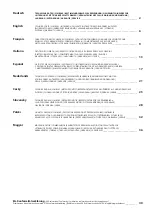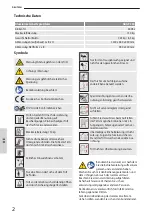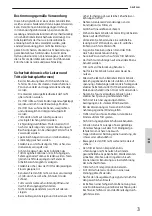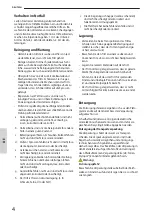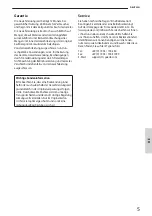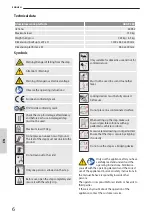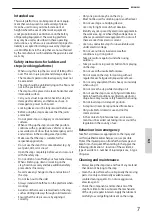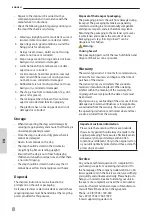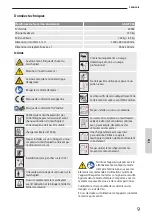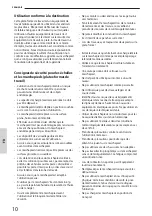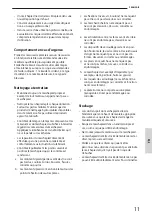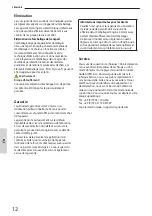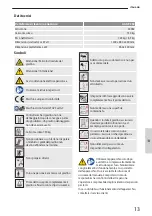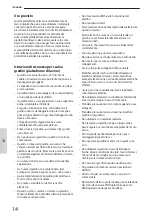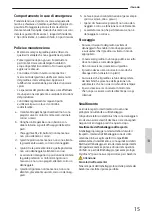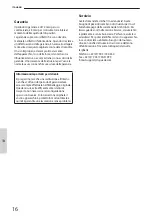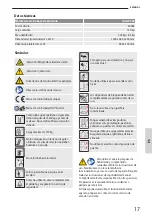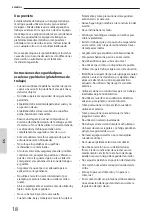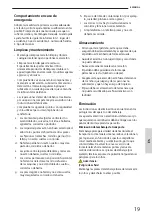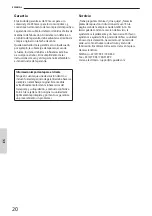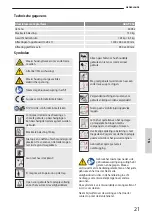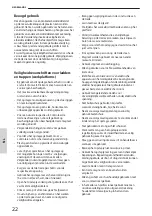
7
EN
ENGLISH
Intended use
This work platform is a mobile piece of work equip-
ment that can be used in a wide variety of places.
It can be used to carry out small-scale work at
heights where the use of other work equipment
is not proportionate (see Ordinance on the Safety
of Operating Equipment). The working platform
may only be used as described in these operating
instructions; any other use is considered improper. No
liability is accepted for damage caused by improper
use. Modifications to the step that are not authorised
by the manufacturer will invalidate the guarantee and
warranty.
Safety instructions for ladders and
steps (working platforms)
• When using this step, there is a risk of falling off or
over. This can injure people and damage objects.
• The maximum permissible load capacity must not
be exceeded.
• The step should be unfolded lying on the floor and
not in the position of use.
• The step must be placed on a level, horizontal and
immovable surface.
• Carry out a visual inspection: Check the step for
damage after delivery and before each use. A
damaged step must not be used.
• Locking devices must be fully secured before use.
• Before using the step, make sure that the joints
are locked.
• Do not place steps on slippery or contaminated
surfaces.
• When setting up the step, ensure that possible
collisions with e.g. pedestrians, vehicles or doors
are avoided. Lock doors (but not emergency exits)
and windows in the working area if possible.
• Make sure that the step is suitable for the
respective application.
• Do not use the step if it is contaminated. (e.g. by
wet paint, dirt, oil or snow).
• Open the step completely before use and secure it
with the safety clip.
• Do not climb on or off with your face turned away.
• When climbing up, down or working on the
step, hold on securely and take additional safety
precautions if necessary.
• Never make any changes to the construction of
the step.
• Do not lean out to the side!
• Always stand with both feet on the platform when
working!
• Avoid work that causes a lateral load on the step,
such as drilling sideways through solid materials.
• Ensure that the step is secure by aligning it
correctly.
• Only one person may be on the step.
• Must not be used for climbing up to another level.
• Do not use step as a bridging device.
• Use only for light work of short duration.
• Identify any risks posed by electrical equipment in
the work area, e.g. overhead high voltage lines or
other exposed electrical equipment. Do not use if
there are risks from electric current.
• Use non-conductive steps for unavoidable work
under electric voltage.
• Do not use outdoors in adverse weather
conditions e.g. strong wind.
• Take precautions against wind when using
outdoors.
• Take precautions to prevent children from playing
on the step.
• Do not use with unsuitable footwear.
• Do not work on the step for too long without
regular breaks. Fatigue will jeopardise safe use.
• Do not carry equipment that is heavy or unwieldy
when using it.
• Do not move the step while standing on it.
• Do not use the step in case of physical limitations.
Certain health conditions, medication, alcohol or
drug abuse may cause a safety hazard when using.
• Do not load steps in transport position.
• A step must never be repositioned from above.
• Only suitable for domestic use and not for
commercial use.
• In the context of professional use, a risk assess-
ment must be carried out taking into account the
legislation in the country of use.
Behaviour in an emergency
Take first aid measures appropriate to the injury and
call for qualified medical help as soon as possible.
Protect the injured person from further damage and
keep him or her quiet. When calling for help, give the
following information: 1. location of the accident, 2.
type of accident, 3. number of injured persons, 4. type
of injuries
Cleaning and maintenance
• Always keep the step clean and free of any material
that does not belong to the step.
• Clean the step after each use. Especially the moving
parts. Use only commercially available, water-
soluble cleaning agents. Do not use aggressive,
abrasive agents.
• Check the components and mechanisms of the
step from time to time. Lubricate the mechanisms
of the step at regular intervals. Apply the lubricant
carefully to avoid getting lubricant on the rungs.



